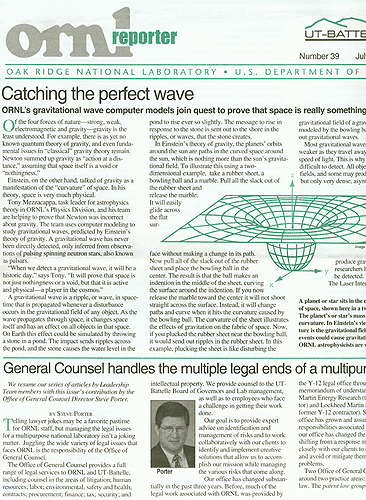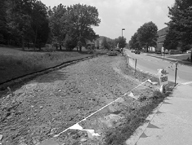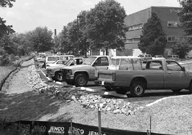 |
| Number 39, July 2002 |
 |
 Catching the perfect wave
Catching the perfect wave
ORNL’s gravitational wave computer models join quest to prove that space is really something
Of the four forces of nature—strong, weak, electromagnetic and gravity—gravity is the least understood. For example, there is as yet no known quantum theory of gravity, and even fundamental issues in “classical” gravity theory remain. Newton summed up gravity as “action at a distance,” assuming that space itself is a void or “nothingness.”Einstein, on the other hand, talked of gravity as a manifestation of the “curvature” of space. In his theory, space is very much physical.
Tony Mezzacappa, task leader for astrophysics theory in ORNL’s Physics Division, and his team are helping to prove that Newton was incorrect about gravity. The team uses computer modeling to study gravitational waves, predicted by Einstein’s theory of gravity. A gravitational wave has never been directly detected, only inferred from observations of pulsing spinning neutron stars, also known as pulsars.
“When we detect a gravitational wave, it will be a historic day,” says Tony. “It will prove that space is not just nothingness or a void, but that it is active and physical—a player in the cosmos.”
A gravitational wave is a ripple, or wave, in space-time that is propagated whenever a disturbance occurs in the gravitational field of any object. As the wave propagates through space, it changes space itself and has an effect on all objects in that space. On Earth this effect could be simulated by throwing a stone in a pond. The impact sends ripples across the pond, and the stone causes the water level in the pond to rise ever so slightly. The message to rise in response to the stone is sent out to the shore in the ripples, or waves, that the stone creates.
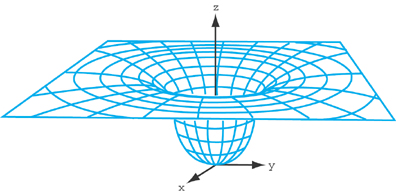 |
| A planet or star sits in the curvature, or “shape,” of space, shown here in a two-dimensional slice. The planet’s or star’s mass causes this spatial curvature. In Einstein’s view, this spatial curvature is the gravitational field. Violent stellar events could cause gravitational waves, which ORNL astrophysicists are working to help detect. |
In Einstein’s theory of gravity, the planets’ orbits around the sun are paths in the curved space around the sun, which is nothing more than the sun’s gravitational field. To illustrate this using a two- dimensional example, take a rubber sheet, a bowling ball and a marble. Pull all the slack out of the rubber sheet and release the marble. It will easily glide across the flat surface without making a change in its path. Now pull all of the slack out of the rubber sheet and place the bowling ball in the center. The result is that the ball makes an indention in the middle of the sheet, curving the surface around the indention. If you now release the marble toward the center it will not shoot straight across the surface. Instead, it will change paths and curve when it hits the curvature caused by the bowling ball. The curvature of the sheet illustrates the effects of gravitation on the fabric of space. Now, if you plucked the rubber sheet near the bowling ball, it would send out ripples in the rubber sheet. In this example, plucking the sheet is like disturbing the gravitational field of a gravitating body, in this case modeled by the bowling ball, which in turn sends out gravitational waves.
Most gravitational waves are weak, and they get weaker as they travel away from their source at the speed of light. This is why gravitational waves are difficult to detect. All objects have gravitational fields, and some may produce gravitational waves, but only very dense, asymmetric objects and events, such as black holes, supernovae and neutron stars—the most extreme objects or cataclysmic events in the universe— produce gravitational waves that researchers hope are strong enough to be detected.
 |
| If LIGO detects gravitational waves, Einstein was right. This chalk portrait by Katie Terpstra won first place in the amateur competition and was voted people’s choice at this year’s Street Painting Festival at the American Museum of Science and Energy. She drew it on a UT-Battelle sponsored space. |
The Laser Interferometer Gravitational Wave Observatory (LIGO) in Livingston, La., recently went live to detect gravitational waves. The detector has two tunnels at right angles to each other. Each tunnel is two kilometers in length. At the corner of the right angles is a laser source. At the end of each tunnel are mirrors attached to test masses. The laser is used to detect even the slightest motion between the test masses, which would be caused by a gravitational wave passing through LIGO. LIGO is able to detect the motion of the test masses with such high precision that if the mirrors move as much as one-trillionth the width of a human hair the motion will be detected.
“To be right there where the first gravitational wave could be recorded was an amazing experience. It blows my mind to think of what this will mean,” Tony said about his recent visit to the LIGO site.
Detection sites are being prepared in remote locations worldwide. The remote sites are selected to try to reduce seismic noise that could interfere with the necessary low signal-to-noise ratio. Multiple sites are also needed for coincidence, to minimize the likelihood of a false-recorded gravitational wave event.
The tubes of the detector are an L-shape because gravitational waves are quadrupolar in nature. This means that as a gravitational wave expands the y-axis, it compresses the x-axis, and vice-versa. The L-shape is sufficient to observe the change in both the x- and y- axes. LIGO detects gravitational waves according to how the space in which it sits changes, confirming that space is an active fabric and not a position holder. LIGO is able to distinguish between different sources of gravitational radiation because each source—whether a black hole, neutron star or supernova—has a different template of characteristics, such as frequency and intensity.
With the IBM supercomputers at ORNL, Tony’s team is applying computer modeling to predict what a gravitational wave from different sources will look like. Tony is leading the collaboration among a number of universities and institutions, supported by DOE’s Office of Science initiative called Scientific Discovery through Advanced Computing (SciDAC), to apply supercomputer modeling to astrophysical phenomena.
“We want to be able to say, ‘This is what a black hole gravitational wave looks like, this is what a supernova gravitational wave looks like,’ and so on,” explains Tony. “We hope to predict neutrino, gamma ray and gravitational wave emissions. The more information we have from the detectors, the better models we can build.”
| With the IBM supercomputers at ORNL, Tony’s team is using computer modeling to predict what a gravitational wave from different sources will look like. |
The computer models could be useful in discovering more information about the formation of black holes, the explosion of supernovae, and other stellar events. Neutrino and gravitational wave information is the most helpful in determining a good explanation of the supernova explosion mechanism because these are generated from deep down in the exploding stellar core.
The detection of gravitational waves would have a far-reaching effect in the fields of physics, astronomy and other sciences. It would prove that what we think about space, as a void or nothingness, is not correct at all.
“It would prove that Einstein’s theory is accurate and that space is an active participant in the events of the cosmos,” adds Tony. “It will be simply amazing to think of space in that way.” —Jodi Lockaby
Jodi Lockaby is Communications and Community Outreach’s summer intern from Dr. Mark Littmann’s science writing program at the University of Tennessee.
 General Counsel handles the multiple legal ends of a multipurpose Lab
General Counsel handles the multiple legal ends of a multipurpose Lab
We resume our series of articles by Leadership Team members with this issue’s contribution by the Office of General Counsel Director Steve Porter.
| by Steve Porter |
Telling lawyer jokes may be a favorite pastime for ORNL staff, but managing the legal issues for a multipurpose national laboratory isn’t a joking matter. Juggling the wide variety of legal issues that faces ORNL is the responsibility of the Office of General Counsel.
 |
| Porter |
The Office of General Counsel provides a full range of legal services to ORNL and UT-Battelle, including counsel in the areas of litigation; human resources; labor; environmental, safety and health, contracts; procurement; finance; tax; security; and intellectual property. We provide counsel to the UT-Battelle Board of Governors and Lab management, as well as to employees who face a challenge in getting their work done.
Our goal is to provide expert advice on identification and management of risks and to work collaboratively with our clients to identify and implement creative solutions that allow us to accomplish our mission while managing the various risks that come along.
Our office has changed substantially in the past three years. Before, much of the legal work associated with ORNL was provided by the Y-12 legal office through funding under a memorandum of understanding between Lockheed Martin Energy Research (the former ORNL contractor) and Lockheed Martin Energy Systems (the former Y-12 contractor). Slowly, the ORNL legal office has grown and assumed all of the legal responsibilities associated with the Lab. In addition, our office has changed the way we do business by shifting from a response mode to working more closely with our clients to identify potential issues and avoid or mitigate them before they become big problems.
Two Office of General Counsel groups are formed around two practice areas: patent law and general law. The patent law group, headed by George Craig, has two other patent attorneys, four patent agents, and three support staff. Their primary function is to identify and protect the intellectual property arising under work performed at ORNL and to assist the Technology Transfer/Economic Development Directorate in the commercialization of that intellectual property. Those commercialization efforts can result in more research dollars flowing into ORNL, assist economic development in our area through the formation of new companies and generate royalties that are used to reward inventors, buy much-needed equipment for the divisions and fund other activities that benefit the Lab.
The patent agents are primarily focused on protecting the intellectual property that is generated at the Lab. They work closely with researchers who suspect that they have generated an invention to define and refine an “invention disclosure” and continue to shepherd that disclosure all the way to an issued patent. In some cases, the patent agents will prepare the patent application themselves; in others, they will work with outside patent lawyers hired to prepare and prosecute the patent application.
Our patent attorneys oversee the intellectual property protection process and also work with commercialization managers, researchers, and program managers on a broad range of contractual relationships with parties outside the Laboratory including CRADAs, Work for Others agreements and licenses. UT-Battelle enters into more than 100 such agreements annually, reports more than 100 invention disclosures to DOE each year and files more than 50 patent applications from those disclosures.
The general law group, composed of five attorneys and two support staff, deals with a very wide range of legal issues. Generally, each attorney has one or more areas of specialized practice and has recognized expertise within those areas. As legal issues arise, the appropriate attorney is assigned to deal with those issues. Each of the support directorates, due to the nature of the legal issues associated with their activities, has a designated attorney for support. Legal issues arising from the research directorates generally cover a broader range of issues, so assignments are made on a case-by-case basis depending upon the subject matter. Most of the general legal issues arising at ORNL are those associated with ES&H, nuclear safety, human resources, labor relations, litigation and contracts, but the practices areas routinely involve many other areas of the law.
The past 18 months have been especially interesting and challenging for our office. The third-party-financed private facilities project has required extraordinary effort from several of the attorneys as well as the support staff. There were significant and unique legal issues associated with that project, and getting six acres of land transferred from DOE, selecting a developer, and securing financing for the project were landmark achievements.
Unfortunately, a number of legal actions arose from the downsizing in November 2000, and those actions provide a major challenge to us as we try to deal with all of the other, everyday legal issues that continue to arise. Currently our largest challenge is managing a burgeoning backlog of worker’s compensation cases arising out of DOE’s retired worker screening program. In 12 months, that caseload has grown from a handful to hundreds of claims as a result of those legacy cases.
The Office of General Counsel is committed to providing expert legal counsel and representation to ORNL and UT-Battelle in a timely and efficient manner. In addition, we are committed to working with our clients to find creative solutions to legal issues that allow our mission to be accomplished while appropriately managing risks associated with the work.
And we do occasionally like to hear a good lawyer joke.
 Three Lab researchers receive Presidential Early Career Awards
Three Lab researchers receive Presidential Early Career Awards
ORNL has three of DOE’s four winners among the latest round of Presidential Early Career Award winners, presented this month by President Bush. The Presidential Early Career Awards for Science and Engineering are the highest honor bestowed by the U.S. government on outstanding scientists and engineers who are beginning their careers.
ORNL’s winners, announced July 11 at the White House, are Vince Cianciolo of the Physics Division, Ian Anderson of the Metals and Ceramics Division and Jizhong Zhou of the Environmental Sciences Division.
ORNL researchers have won 10 PECASE awards since they were begun in 1996.
 |
| Cianciolo |
Vince Cianciolo, the fourth Physics Division researcher to win a PECASE, was cited for his leadership in developing a unique scientific program and an experimental detector to search for quark-gluon plasma formation at the Relativistic Heavy Ion Collider. RHIC, located at Brookhaven National Laboratory, has had a major representation of ORNL researchers and engineers who designed and built significant portions of the PHENIX detector, including Vince. Experiments with RHIC and PHENIX will shed new light on the state of the universe moments after the Big Bang.
“My particular interest is focused on an exotic particle, known as the J/y,” says Vince. “These particles are created in heavy ion collisions (although rarely) and are cleanly observed by PHENIX. Because of the nature of these particles they are expected to be especially sensitive to the earliest stages of an ion collision, when the conditions are hottest and densest. By looking at many collisions containing this information we hope to come to a more complete understanding of how the laws of physics change under such extreme conditions.”
 |
| Anderson |
Ian Anderson was cited for his leading-edge research in the development of electron beam microcharacterization techniques for materials R&D. He is noted for his ability to use his in-depth understanding of electron optics and electron interactions with matter to design experiments, execute them and develop physics-based mathematical models to gain insight from the information they produce.
Ian is considered a leader and innovator in the fields of quantitative spectrum imaging using linear multivariate statistical analysis and atom location by channeling-enhanced microanalysis, called ALCHEMI. He manages ORNL’s Shared Research Equipment (ShaRE) user facility, one of DOE’s electron beam microcharacterization facilities. His research has contributed significantly to the understanding of strengthening mechanisms in a number of advanced materials.
 |
| Zhou |
Jizhong (Joe) Zhou, a former Alexander Hollaender Fellow, has distinguished himself as a leader in four fields: genomic/molecular technologies for ecological and environmental studies; functional genomics of environmental microorganisms; microbial community diversity and dynamics; and microorganisms in extreme environments.
His research has pioneered several areas. He first demonstrated that microarray-based genomic technology can be used to analyze microorganisms in complex environmental samples. He has developed several novel high-throughput genomic technologies, including functional gene arrays, community genome arrays and oligonucleotide arrays for analyzing microbial communities in complex environmental samples.
Joe was among the first to demonstrate and validate the usefulness of microarrays for monitoring gene expression in prokaryotes and demonstrated that microarray hybridization can be used to reveal gene-specific differences among closely related microorganisms. His studies have shifted the direction of microbial ecology and biodiversity toward understanding the mechanisms that shape diversity and, hence, the means of manipulating a community. He recovered the most ancient viable cultured bacteria from the deepest subsurface (2,000 meters underground) and was the first to observe that magnetite can be produced and metals can be reduced at subzero temperatures.—B.C.
 Boykins, Turner lead 2002 United Way Campaign
Boykins, Turner lead 2002 United Way Campaign
Events since last year’s United Way Campaign have underscored the importance of giving. ORNL’s 2002 United Way Campaign gets under way in late July, with Human Resources Director Darryl Boykins (chairman) and Chief Financial Officer Greg Turner (co-chairman) at the helm.
“The Lab’s 2001 campaign was one of the most successful in East Tennessee, and it was indicative of the commitment of ORNL staff members to enhancing the quality of our communities,” Darryl says. “We hope we can sustain our traditional level of giving this year, particularly since many area agencies have experienced reduced levels of financial support since September 11. Understandably people were eager to do what they could to help those in New York, Washington, D.C., and Pennsylvania; however, in some cases, it meant that we were not able to do quite as much to assist our neighbors closer to home. During our campaign, we’ll re-focus on those crucial needs here in our area.”
Leadership givers, always an important element in a UW campaign, will be contacted mid-month. Details of the campaign kickoff extravaganza will be announced soon.
Tell your story: If you have a personal story to share about how a United Way agency has made a difference among your family members or friends, please contact Cindy Ross Lundy (e-mail lundycr, or phone 574-1642).
 A new critter on the ORR
A new critter on the ORRSightings of a new animal on the Oak Ridge Reservation have been confirmed. When someone told ORNL Reporter that they thought they had seen an elk on Bethel Valley Road, we asked ORNL Wildlife Coordinator Warren Webb if it was true.
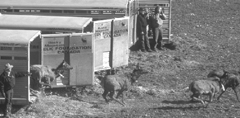 |
| A Royal Blue elk release: Some headed for the ORR. |
Warren says there are two and possibly three elk on the reservation: “They are apparently using it as part of their rather large home range,” Warren says. “Elk or elk signs (e.g., tracks) have been seen at EGCR, Gallaher Bend, and SNS, among other places.”
Warren says the elk are part of several groups of the animals released by the Tennessee Wildlife Resources Agency at the Royal Blue Wildlife Management Area. The release area includes parts of Campbell, Scott, Morgan, Claiborne and Anderson counties, as well as the Royal Blue area, Frozen Head State Park and the Cumberland Gap National Park. The TWRA released 50 elk in December 2000 as part of a program to reestablish herds in the Southeast. Two more releases have occurred since then.
The state’s native elk had been eradicated by the end of the Civil War. The reappearance of the big animals on the ORR is one more reason to drive cautiously on Bethel Valley Road.
 Graphite Reactor Museum gets an upgrade
Graphite Reactor Museum gets an upgrade
If you haven’t been there lately, you ought to drop in. The Graphite Reactor Museum has been refurbished just in time for the 2002 public tour season.
The Graphite Reactor, of course, is a historic attraction on the site of the first functioning nuclear reactor, a follow-on to the successful University of Chicago “pile” experiment. The reactor is still there—you can walk right up to its loading face—as are the control rooms. A team led by Enrico Fermi achieved criticality in November 1943. The reactor served as a pilot project for a complex of plutonium-producing reactors in Hanford, Wash., and its operation continued after the war with a long reign of service and discovery.
The new Graphite Reactor museum includes new, updated exhibits. Thirteen new panels now grace the exhibit area—two each for the major Lab research areas of life sciences, high-performance computing, national security, materials science and energy plus an extra panel for, of course, neutron science, which was invented at the GR.
Early impressions from visitors have been very positive. The public can best access the museum by signing up for the Oak Ridge Public Tour, which runs Tuesdays through Fridays at the American Museum of Science and Energy, where they do the required registration.
 New user facility opens, new homes on horizon
New user facility opens, new homes on horizon
ORNL dedicated its 20th user facility on June 17. The Cooling, Heating and Power Integration Laboratory enables researchers from industries, universities and other institutions to conduct tests on distributed energy products and systems.
Distributed generation is electricity produced on site using fuel cells, microturbines and renewable electric systems and technologies. Distributed energy resources make use of energy normally wasted in the generation of power by combining electricity generation with heating and cooling systems.
The Lab’s R&D programs on heating, cooling and ventilation go back to the early 1970s. One guest at the dedication, TVA Board Chairman Glen McCullough, pointed out why that research has taken on new significance, noting that Energy Secretary Spencer Abraham, who visited the Lab almost exactly one year earlier, “has linked national security to energy security.”
Lab Director Bill Madia said that for a nation with a projected need of 1,200 new power plants, distributed energy, renewable resources and improved power transmission and other technologies will come into play. “Technology is a central part of that solution,” Bill said.
That same day, Buildings Technology Center Director Jeff Christian announced that ORNL would lead an effort to build 20 “zero energy” Habitat for Humanity homes in Lenoir City’s Harmony Heights subdivision. Read more about that on page 5.
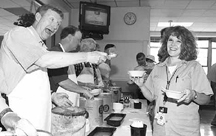 |
| Engineering Division Director Tom Etheridge demonstrates his wicked serve to Rebecca Bunch during June 7’s ice cream celebration of one million safe work hours. |
The June Reporter went to press before ice cream was served on Friday, June 7. Lab managers and safety personnel scooped out several flavors at the ORNL Cafeteria, the 4500-South Canteen, the Spallation Neutron Source offices, Building 7012, the High Flux Isotope Reactor and the National Transportation Research Center.
It was all for a good cause in that the Lab reached one million hours without a lost workday away case. Lost workdays are counted when someone has been injured on the job seriously enough to miss work. Getting to a million hours without a lost workday was a milestone: The only other times that mark had been reached in the past five years were in October 1998 and in February 2000. At press time for the July issue, the good news continued with more than 75 consecutive days, or 1.4 million hours, without a lost workday case. You can watch the numbers at www.safety1st.ornl.gov.
 Future Car Congress includes test drives
Future Car Congress includes test drives
More than 800 people from the transportation and related industries attended the 2002 Future Car Congress held June 3-6 in Arlington, Va. ORNL worked on the planning and implementation of the conference, which focused on the future use of hydrogen fuel cells to power automobiles 20 years down the road.
The three-day conference addressed issues involved in the development of automotive technologies aimed at dramatically reducing the world’s transportation energy consumption and minimizing vehicle emissions.
With an emphasis on recent fuel-cell technology developments a number of fuel-cell vehicles, as well as electric vehicles, were on display and available for test driving at the Turner-Fairbank Highway Research Center in McLean, Va.
The conference also included panel discussions on transportation issues involving officials from government and the automotive industry, along with the presentation of 118 technical papers, 20 of which were presented by ORNL researchers. Some of the papers delivered by ORNL researchers covered the topics of heat transfer, machine copper rotors, composites, carbon fiber and lightweight metals and alloys.
| —Reported by Bill Cabage |
 Goal of zero
Goal of zero
BTC’s Lenoir City project includes first Habitat International Zero Energy building
Electric bills could be a thing of the past, thanks to the powerful technologies of Net Zero Energy Building houses, which would make houses of the future power generators as well as power consumers.Net Zero Energy Building houses are designed to include technologies that allow energy to be produced, as well as used efficiently, directly in the home. This approach reduces energy costs. When houses reach the goal of producing as much energy as is used, electric bills drop to zero.
“The lessons taught by these houses will be to show builders, utilities, and home owners the “leap frog” integrated technologies on the near horizon,” says Jeff Christian, director of ORNL’s Buildings Technology Center.
Twenty new houses will mark the commitment of ORNL, the Department of Energy, the Tennessee Valley Authority, and private industry to a Habitat for Humanity Subdivision of Technologies for Zero Energy Buildings. The prototype houses will showcase a variety of energy-production enabling technologies, such as solar electric cells, as well as energy-efficient appliances, such as heat pump water heaters and refrigerators. The goal is to have these technologies marketable by 2010.
“Our vision is to build a series of prototype houses,” Jeff says. “Some will be Building America houses using efficient appliances and design, and some will be Net Zero Energy houses capable of capturing and producing electricity.”
DOE’s Building America Teams partner with builders to construct practical, cost-effective and energy-efficient housing. Building America homes use 50 percent less electricity than average houses because of improved heating, ventilation and air-conditioning units and water-heating systems. These energy-saving technologies can be incorporated into houses at an additional cost to the builder of less than $1000. In some plans there is no additional cost to attain the energy savings.
| “How it all came together is one happy tale.” |
Net Zero Energy Buildings are designed to consume no more power than is generated on site on an annual average basis. When the homeowners need additional power, it can be pulled off the power grid. TVA can also buy back excess electricity produced to help meet peak demands for power. It is hoped that the give and take of this power will balance out at a yearly average of zero. Net Zero Energy Building houses are up to 90 percent more efficient than the average house.
Net Zero Energy Building homes are primarily powered by a photovoltaic system that uses solar collectors to turn sunlight into household electricity. As the technologies are developed, ORNL researchers hope to introduce into the houses other methods of collecting and converting energy into useable electricity, some quite novel such as a small wood boiler coupled with a small microturbine. Efficient appliances, such as heating and cooling systems, and structural materials are also important in an energy-efficient design.
“Houses today tend to be leaky, taking in and releasing hot or cold air,” says Jeff.
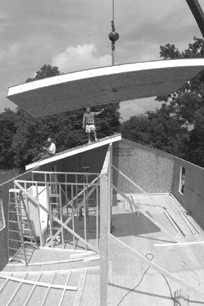 |
| A roof panel is installed on the Lenoir City house, which went up in just three days. The house will have a heat-pump water heater and may be the testbed for a wood-fired microturbine that will generate electric power. The roof will also have solar panels. |
Net Zero Energy Building houses will be built airtight. The first prototype uses structural insulated panels. The panels consist of a layer of insulated foam sandwiched between two layers of oriented strand board. The wood is glued to the foam to form a solid panel, which when correctly fastened to the other panels form a very tight building envelope. Structural insulated panels form the house’s entire outer envelope-they provide the structure, insulation and airtight barrier for the roof, floor, and walls.
ORNL’s vision for these homes started at a strategic planning meeting on March 18-19 that placed Net Zero Energy Buildings as a top activity. At a conference in Washington, D.C., DOE Assistant Secretary David Garman encouraged Jeff’s plans by emphasizing the need to “reduce the burden of energy prices on the disadvantaged.” Jeff spoke with DOE program sponsor George James and received approval to move forward.
Next, Jeff visited with TVA personnel and found them very receptive to this concept because of the benefits of providing peak cooling demand. TVA provided ORNL 10 kW of solar thin film PV collectors and some funding to start investigating. With the collectors in hand, Jeff approached the Habitat for Humanity board of directors and proposed the idea of building a quick solar carport to have something to show off at the DER/ZEB Showcase held in June. The directors suggested that carports might set an unneeded precedence for others in the neighborhood, and said, “How about a house?” Jeff returned to DOE and TVA with the idea of developing the first Habitat International Building America zero energy house. This would provide a real concept house to launch construction of 20 exciting prototypes consisting of both Building America and Net Zero Energy Building standards.
“Whole houses put it all together,” Jeff says. “ORNL and the Loudon County Habitat up until this first ZEB worked together only on specific building components—like the walls or the HVAC system R&D. With the plan in hand, the Structural Insulated Panel Association was approached to explore their interest in partnering on this project. The response was overwhelming. Five structural insulated panel manufacturers offered panels to complete five Habitat houses in this ‘ZEB Village.’ Panel design was initiated May 28. Within a week Pacemaker Plastics, a structural insulated panel manufacturer out of Ohio, sent different plans for the home to fit the 1067-square-foot floor plan. Habitat started construction on June 1. The footers, pillars and crawl space walls were completed and backfilled on June 17. The panels were shipped and arrived on site at 8 a.m. June 17, the day of the DER/ZEB showcase. Everything fell into place very quickly.”
The program has continued to gain support. After a talk at the Loudon County Civitan meeting, several company representatives offered services and materials for the program. TVA continued their support by making a significant commitment to the program.
“Over the next three years, TVA will sponsor five homes in this zero energy neighborhood,” announced Glen McCullough, TVA chairman, at a dedication ceremony for ORNL’s Buildings Technology User Facility on June 17. Jeff hopes that TVA’s commitment will challenge others to make similar commitments.
“We have overwhelming support for this program,” says Jeff. “How it all came together is one happy tale.”
The first Building America Zero Energy Building Habitat International House in the world was built in late June. ORNL will monitor the house for a short time for experimentation, but a family of four will move in shortly after construction is completed. The house and the family will become a part of a virtual laboratory and the concept of Net Zero Energy Building homes will be evaluated under actual conditions. “ This is more that just a house,” says Jeff. “This is a landmark that will be recorded in history as the first Building America Habitat ZEB.—Jodi Lockaby
|
 |
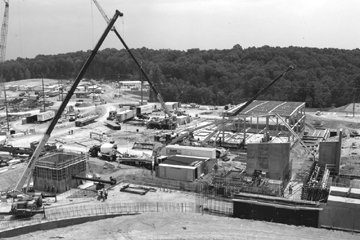 |
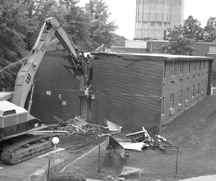 |
 |
 |
| Buildings are coming down, too. Building 6003, one of three slated for demolition, was razed on June 25. | Work on the Spallation Neutron Source on Chestnut Ridge and the privately funded facilities on the main campus is in full swing. |
|
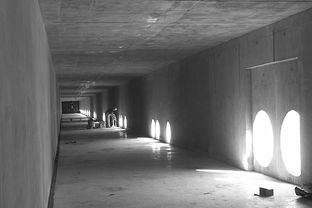 |
 |
|
| The SNS’s linac tunnel, now underground, saw daylight for a time. | If you build a parking lot, they will come. Spaces on Southside Drive were filling up a few days after they were completed. |
 AMSE exhibit brings back posters of WWII
AMSE exhibit brings back posters of WWII
Old-timers will probably recall seeing a few tacked up around here: Produce for Victory! Posters on the American Homefront, 1941-45, a Smithsonian Institution traveling exhibition that focuses on posters circulated in the United States during World War II to promote patriotism and to increase industrial productivity, will be on display this summer at the American Museum of Science and Energy.
 |
AMSE, in cooperation with Humanities Tennessee, will host the final statewide showing of the exhibition, which has traveled to eight Tennessee communities over the past 12 months. It will be on view through August 11.
The Smithsonian portion of the exhibition features 25 reproductions of WWII posters from the collections of the Smithsonian Institution’s National Museum of American History. AMSE is adding a statewide component to the exhibit titled “World War II: Tennessee Home Front”, a six panel exhibition with artifacts that showcase Tennessee’s industries production, aviation training, and land maneuvers. A WWII victory garden is an outdoor exhibit at AMSE that features the prescribed plantings.
The posters in Produce for Victory!—displayed in factories, shop windows, schools and other public places around the country—rallied a nation to take the steps necessary at home to support soldiers in the field. Citizens were instructed to conserve automobile fuel by carpooling, to organize scrap drives and to grow victory gardens to reduce the burden on the nation’s farmers who were growing crops for overseas consumption. The exhibition especially concentrates on how the patriotic movement affected factory workers, as management pushed them to become more productive on the job.
Produce for Victory! is one of a series of exhibitions circulating nationally as part of Museums on Main Street, a collaborative partnership between the Smithsonian and state humanities councils across the country, in cooperation with the Federation of State Humanities Councils.—Reported by Lissa Clark
 Senior superlatives added to ORNL’s list
Senior superlatives added to ORNL’s list
Last issue we gave an impressive list of area students—the children of Lab employees—who were tops in their high school classes. There are more. Stuart Hanson, son of Paul Hanson of the Environmental Sciences Division and Nancy, was valedictorian at Oliver Springs High School. Josh Lankford, son of Trish Lankford in the Life Sciences Division and Roger, at Bechtel Jacobs, was salutatorian.
 Physics’ Director Fred Bertrand ends a productive watch
Physics’ Director Fred Bertrand ends a productive watch
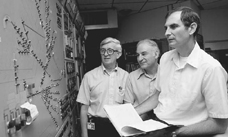 |
| Fred Bertrand (right) looks at a map of ORIC beam lines with Noah Johnson (left) and Dan Horen in this 1986 photo. |
Fred Bertrand is retiring as director of the Physics Division after 33 years of service at ORNL. As Physics Division director, Fred oversaw the development of the Holifield Radioactive Ion Beam Facility into one of the world’s leading low-energy nuclear physics research facilities. During his tenure, an unprecedented four research staff members in the Physics Division were awarded Presidential Early Career awards.
He’s being succeeded by Glenn Young, currently the Experimental Nuclear Physics group leader and deputy spokesman of the PHENIX experiment at the Relativistic Heavy Ion Collider at Brookhaven National Laboratory.
Fred received his Ph.D. in physics in 1968 from Louisiana State University. He joined the research staff in the ORNL Physics Division in 1970 following the completion of research associate appointments at ORNL and the University of Southern California. He has published more than 200 papers in nuclear structure and giant resonances. He served as a group leader, section head and associate division director before being named director in 1995. Fred is a fellow of the American Physical Society and has served on numerous DOE and National Science Foundation panels.
 Retirement savings seminars continue
Retirement savings seminars continue
Benefit Plans’ retirement savings seminars have begun a new round. On the third Monday of each month, Benefits Management’s Michael Moore will present a series of seminars titled, Your Savings Plan: Charting Your Retirement Security. The two-hour sessions (4:30–6:30 p.m.) will be held at the Benefit Plans offices, 104 Union Valley Road, Oak Ridge. All interested UT-Battelle and BWXT-Y-12 employees and their spouses are welcome. Remaining scheduled sessions are on July 15, August 19, September 16, October 21, November 18 and December 16.
Session topics include “What’s It All About: An Introduction to the Savings Program”; “Selecting Investments for My Savings Plan: An Introduction to Basic Investing Concepts”; “Planning for Retirement: An Overview of the Economics of Retirement and the Need for Personal Financial Planning”; and a session of special topics and a question and answer session.
 ORNL wins three R&D 100 awards, adds to lab-leading total
ORNL wins three R&D 100 awards, adds to lab-leading total
ORNL researchers have won three R&D 100 Awards from R&D Magazine, which annually gives awards for the 100 most significant innovations of the year. ORNL has the national lab-leading total of 112 since the awards began in 1963 and is second only to General Electric.
Lab Director Bill Madia says the three R&D 100 awards “are once again a tribute to the truly outstanding talent of our research staff. Year after year, the science and discoveries at ORNL are recognized among the best in the world.”
The honors were for the following processes or inventions:
Any Source, Any Position Fluid Handler (ASAP), developed and submitted jointly by Mitch Doktycz, Life Sciences Division; Steven Hicks, Engineering Science and Technology Division; and Innovadyne Technologies of Santa Rosa, Calif.
ASAP enables the high-speed transfer of small volumes of liquid between source and target. The ability to transfer small amounts means that less liquid is used during experimentation and development, translating into significant cost savings.
ORNL Spiral Notch Torsion Test, developed and jointly submitted by Jy-An Wang, Nuclear Science and Technology Division; Ken Liu, Metals and Ceramics Division; and Inventure Laboratories of Knoxville.
The Spiral Notch Torsion Test is a portable system that tests fracture toughness and strength of materials, such as ceramics, composites, polymers, carbon foam and concrete, to be used in designs. This system will provide engineers with state-of-the-art materials testing and analysis to aid in design work, with the primary aim to prevent accidental cracking or breaking of the structural materials.
DSI AIR: Defect Source Identifier–Automated Image Retriever, developed and jointly submitted by Ken Tobin, Tom Karnowski and Regina Ferrell, all from the Engineering Science and Technology Division, and Applied Materials of Santa Clara, Calif.
DSI AIR is a software product that solves manufacturing problems in semiconductor fabrication environments. The system works by comparing images of the product defect against hundreds of thousands of historical images that are maintained in the plant’s data management system. DSI AIR uses a unique image description of the defect and background region to describe, index and rapidly retrieve information from the database. —Jodi Lockaby
 ORNL people
ORNL people
ORNL researchers Phillip Bingham, Matt Chidley, Jim Goddard, Jim Hardy, Greg Hanson, Kathy Hylton, Jeff Price, Chuck Schaich, John Simpson, Ken Tobin and John Turner of the Engineering Science and Technology Division, and Larry Baylor and Dave Rasmussen of the Fusion Energy Division have been awarded the 2002 Federal Laboratory Award of Excellence in Technology Transfer for their direct-to-digital holography process. The technology allows for high-speed and high-sensitivity detection of defects in semiconductor device structures.
ORNL received the lion’s share—four of seven—of this year’s Battelle Critical Science and Technology Challenges. Each year Battelle gives up to ten $1,000 awards for researchers’ ideas on the critical science and technology challenges facing Battelle and its affiliated national laboratories over the next 3 to 10 years. ORNL’s four winners are Gyula Eres (Solid State Division) and David C. Joy (Metals and Ceramics Division), “Nanoscale Materials Processing Using Ultra Low Energy Electron Beams”; Andrei Gakh (National Security Directorate), Peter Bonnesen and Bruce Moyer (Chemical Sciences Division), “Chiral Extraction”; Felix L. Paulauskas and Cliff Eberle (M&C Division), “Inexpensive Precursors and Processes for Manufacturing Carbon Fibers”; and Steven H. Overbury and Sheng Dai (Chemical Sciences Division), “Active Nanoporous Membranes for Ultra-selective Catalysis and Separation.”
The Office of Science has asked the Fusion Energy Sciences Advisory Committee to form a high-level panel to use the results of the Fusion 2002 Snowmass Summer Study and recommend U.S. strategy for the next step—a fusion burning plasma experiment. FED’s Stan Milora and Nermin Uckan, along with John Sheffield (JIE/ORNL) will be serving.
The Lab has filled several vacancies recently. David Hill is coming to ORNL as director of the Nuclear Science and Technology Division. He comes from Argonne National Laboratory, where he has been deputy associate laboratory director for Engineering Research. Brian A. Worley has been named director of the Computational Sciences and Engineering Division. Brian has been acting director of CSED since the division was formed in October 2001. Glenn R. Young will succeed Fred E. Bertrand, Jr., as director of the Physics Division, effective July 1 (see page 7). Glenn is currently leader of the Experimental Nuclear Physics group and deputy spokesman of the PHENIX experiment at the Relativistic Heavy Ion Collider at Brookhaven National Laboratory.
ORNL office: P.O. Box 2008, Oak Ridge, TN 37831-6146, Building 4500-S, Room F-60, MS 6146
ORNL help line (ethics; fraud, waste and abuse; quality; ES&H)
576-9000
[an error occurred while processing this directive]
[an error occurred while processing this directive]
Bill Cabage, lead editor, ORNL, 574-4399 (cabagewh@ornl.gov)
Deborah Barnes, associate editor, 576-0470 (barnesds@ornl.gov)
Ombudsman: 576-7802
DOE inspector general hotline: 1-800-541-1625
